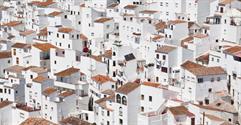In today’s society we are more aware than ever of the damage we inflict on our planet, yet adopting a sustainable, energy saving and efficient lifestyle has never been easier.
Gone are the days when brick and concrete ruled supreme,
Enter the eco-home: a living environment designed and constructed in a way which promotes sustainable design, development and ways of living.
Built using materials that reduce waste and energy consumption, the concept has grown in popularity, becoming a growing part of the UK property scene.
In 2009 buildings accounted for around 43% of all of the UK's carbon emissions and buildings can also damage the environment through poor waste management and inefficient use of resources.
However, there are now a number of options available to people wishing to design their own eco-friendly homes, alongside government incentives.
Alternative building techniques
Architects, builders and engineers are now utilising
Rammed earth construction - An ancient method, involving clay-based material mixed with water and then rammed into a solid wall form.
Cob buildings - Similar to the above method, using a combination of soil, sand, straw and water.
Underground - Earth shelters, built entirely or partially underground, absorbing the geothermal heat.
Earth Bag - Comprising of bags filled with earthen materials (such as crushed volcanic rock), stacked to create walls.
Straw bale - The core structure is made up of compressed straw (believe it or not but straw is an amazing insulator, holds air filtration qualities and its even fire resistant).
Sustainably sourced wood /stone - Built using reclaimed stone, recycled and reused from demolished buildings or sustainably sourced materials.
Shipping Containers - Repurposed shipping containers, are rising in popularity with their trendy urban aesthetic.
Earth Ships - Made from recycled car tyres filled with earth, amongst other things you might consider ‘rubbish’ – like recycled cans and bottles.
5 Eco exemplars
There are now many examples of eco-building ranging from simplistic DIY designs to more elaborate builds and sustainable eco-communities. We take a look at 5 properties at the vanguard of eco-living:
Lammas, Pembrokeshire, Wales
Lammas is Britain’s first ever eco-village. Self-described as ‘a collective of ‘eco small holdings working together to create and sustain a culture of land-based self-reliance’, their houses are built from natural and recycled materials.
With their turf roofs and cob walls, their houses closely resemble the hobbit holes of Tolkien’s shire. This alternative model of living, has no mains water, gas or electric. Instead, they have a permaculture approach to living off the land.
Their power comes
BedZed, London
In the London borough of Sutton, BedZed is a great example of urban and sustainable living with its 82 housing units. Built by leading zero carbon design and development Architects Zedfactory, their aim was to source materials from within a
The complex utilises
Slip House, Brixton, London
This modern urban dwelling really stands out next to its traditionally terraced neighbours. The three storey translucent structure is made from repurposed stacked containers and glass. The Slip House project was filmed for Channel 4's Grand Designs.
The property boasts a wealth of different features, helping it to achieve a level 5 in the Code for Sustainable Design.
With a hidden roof terrace with solar panels,
Underhill House, Gloucestershire
The most visible part of the property comprises of a more conventional barn conversion. However, the north side of the property is buried underground, eliminating the need for central heating. The house may be underground, but by no means does it resemble a burrow, the south facing, triple glazed windows maximise the natural light and the solar panels provide electricity.
Zero Carbon House, Balsall Heath, Birmingham
The award winning Zero carbon house was the first UK home to achieve the highest level (level 6) in the government’s Code for Sustainable Homes (when the code was in place) - making it the most sustainable property in the country.
Built around a pre-existing 2 bedroom Victorian house, the modern extension transformed it into a 4 bedroom with a studio loft. The design simultaneously juxtaposes and compliments the traditional red brick architecture that surrounds it.
Carbon neutral, producing as much energy as it consumes, and using 14 reclaimed materials, here are just some of its features:
35 square metres of solar panels
Airtight draft proof membrane and recycled paper for insulation
Rammed clay flooring – from the foundations of the property
Washing machine and toilet connected to a tank in the cellar that stores harvested rainwater
Skylights to minimise the need for lights
Kitchen counters made from recycled glass
Tables made from repurposed signs
Stair rail made from hemp
John Christopher, the architect behind Zero Carbon House states in the Guardian:
"It is designed to protect the environment and enable its occupants to enjoy the environment"
The house is regularly opened to the public, its aim to inspire others and in one day drew in am impressive 600 visitors.
Are you keen for green?
With eco-homes and developments becoming a more prominent part of our property landscape, the future certainly looks promising.
Many regions in the UK now have a Centre for Sustainability - an educational centre with ecological and sustainable development issues at their core, offering eco-construction courses and advice.
However, if you’re not considering building or buying your very own eco-home, the government are also taking steps to reduce the carbon footprint of pre-existing homes.
The Green Deal home improvement fund (GDHIF) has proved incredibly popular, whereby people can claim money from the government in the form of a loan to make their homes more energy efficient.
The savings you make on your energy bill will go towards the repayment of the loan. Its aim: to save you money and lower your property's carbon footprint in one big step towards a sustainable future.


